Multi-Classification Using YOLOv11 and Hybrid YOLO11n-MobileNet Models: A Fire Classes Case Study
Abstract
:1. Introduction
- We created a new dataset for fire classification that covers Classes A, B, C, and F/K, which was validated by firefighting experts. This dataset combined different images from five benchmark existing datasets. Moreover, additional images are added manually to the dataset;
- We developed fire classification models based on YOLOv11, using five different YOLO11 variants applied to our dataset. All YOLO11 variants show excellent performance. YOLO11n, YOLO11m, YOLO11s, and YOLO11l models showed the highest performance, especially in classifying challenging categories like Class F/K;
- We developed a hybrid model based on YOLO11n and MobileNetV2 that outperformed other YOLO11 models in terms of macro metrics;
- A comparison with a similar study and other models such as the YOLOv8n model and YOLOv8s model was also performed to show the performance of the proposed hybrid model;
- We discussed the potential of YOLO11 for fire classification and highlighted challenges and limitations related to the scarcity of comprehensive fire datasets.
2. Related Studies
3. Methodology
3.1. Dataset
3.2. YOLO11
3.3. MobileNetV2
3.4. Performance Metrics
3.4.1. Accuracy
3.4.2. Precision
3.4.3. Recall
3.4.4. F1 Score
4. Results
5. Discussion
- To the best of our knowledge, there is only one dataset specifically for the classification of fire classes that includes four fire classes and no fire class [27]. The limited datasets make it challenging to train models that can accurately identify classes of diverse fire types across real-world scenarios. This highlights the need for more comprehensive datasets to improve fire classification accuracy of models;
- An unbalanced dataset can lead the model to favor majority classes, like Class A, and perform poorly on minority classes. Despite this, YOLO11 successfully classified most fire instances with high accuracy. However, it struggled with a few images in smaller classes, such as Class F, where the limited data made accurate classification more challenging.
- Building a dataset for fire classification is challenging because not all fires can be identified visually. Some require additional characteristics, such as recognition by sound. Fire classes are not directly determined by the type of object. For instance, building fires can be classified as Class A or Class B depending on the materials involved in the fire. The classification should be based on the materials causing the fire. This complexity makes accurate classification more difficult;
- Some fires can belong to multiple classes, as they can share characteristics from more than one category. To address this, it might be beneficial to introduce additional fire classes that represent these combinations, effectively capturing complex fire types. This approach could improve model accuracy by allowing classification for cases where fires do not fit into a single predefined category;
- The YOLOv11 versions are highly advanced models, with YOLO11n, YOLO11m, YOLO11s and YOLO11l delivering particularly promising results. A comparison study [39] highlights that YOLO11m, YOLO11n, and YOLO11s achieve high accuracy, low processing time, efficient power consumption, and minimal disk usage. This performance is attributed to the use of C3k2 and C2PSA blocks, which enhance feature extraction and preserve contextual information, resulting in improved convergence and overall performance [39]. The proposed hybrid model, which integrates YOLO11n with MobileNetV2, demonstrates superior performance across macro metrics.
6. Conclusions
Funding
Institutional Review Board Statement
Informed Consent Statement
Data Availability Statement
Acknowledgments
Conflicts of Interest
Appendix A
| Test Results of Fire Dataset [25,29] | |||
|---|---|---|---|
| Precision | Recall | F1 score | |
| Class A | 0.98 | 0.95 | 0.96 |
| Class B | 1.00 | 1.00 | 1.00 |
| Class C | 0.90 | 0.95 | 0.92 |
| Class F | 0.94 | 0.94 | 0.94 |
| No Fire | 0.95 | 0.96 | 0.95 |
| accuracy | 0.96 | ||
| Macro avg | 0.95 | 0.96 | 0.96 |
| Weighted avg | 0.96 | 0.96 | 0.96 |
| DFAN Dataset | ||||||
|---|---|---|---|---|---|---|
| Fine-Tuning Results | Non-Fine-Tuning Results | |||||
| Precision | Recall | F1 Score | Precision | Recall | F1 Score | |
| Class A | 0.78 | 0.78 | 0.78 | 0.22 | 0.33 | 0.27 |
| Class C | 0.92 | 0.95 | 0.94 | 0.59 | 0.65 | 0.62 |
| Class No Fire | 1.00 | 0.93 | 0.96 | 0.76 | 0.35 | 0.48 |
| Accuracy | 0.92 | 0.50 | ||||
| Macro avg | 0.90 | 0.88 | 0.89 | 0.52 | 0.45 | 0.45 |
| Weighted avg | 0.92 | 0.92 | 0.92 | 0.56 | 0.50 | 0.51 |
| Forest fire dataset | ||||||
| Class A | 1.00 | 0.94 | 0.97 | 0.64 | 0.96 | 0.77 |
| Class No Fire | 0.95 | 1.00 | 0.98 | 0.92 | 0.45 | 0.61 |
| Accuracy | 0.97 | 0.71 | ||||
| Macro avg | 0.98 | 0.97 | 0.97 | 0.78 | 0.71 | 0.69 |
| Weighted avg | 0.97 | 0.97 | 0.97 | 0.78 | 0.71 | 0.69 |
| Forest smoke and fire dataset | ||||||
| Class A | 0.94 | 1.00 | 0.97 | 0.81 | 0.49 | 0.61 |
| Class No Fire | 1.00 | 0.90 | 0.95 | 0.60 | 0.87 | 0.71 |
| Accuracy | 0.96 | 0.67 | ||||
| Macro avg | 0.97 | 0.95 | 0.96 | 0.70 | 0.68 | 0.66 |
| Weighted avg | 0.97 | 0.96 | 0.96 | 0.71 | 0.67 | 0.66 |
| Bowfire dataset | ||||||
| Class A | 0.83 | 1.00 | 0.91 | 0.95 | 0.72 | 0.82 |
| Class No Fire | 1.00 | 0.86 | 0.92 | 0.81 | 0.97 | 0.88 |
| Accuracy | 0.92 | 0.86 | ||||
| Macro avg | 0.92 | 0.93 | 0.92 | 0.88 | 0.84 | 0.85 |
| Weighted avg | 0.93 | 0.92 | 0.92 | 0.87 | 0.86 | 0.85 |
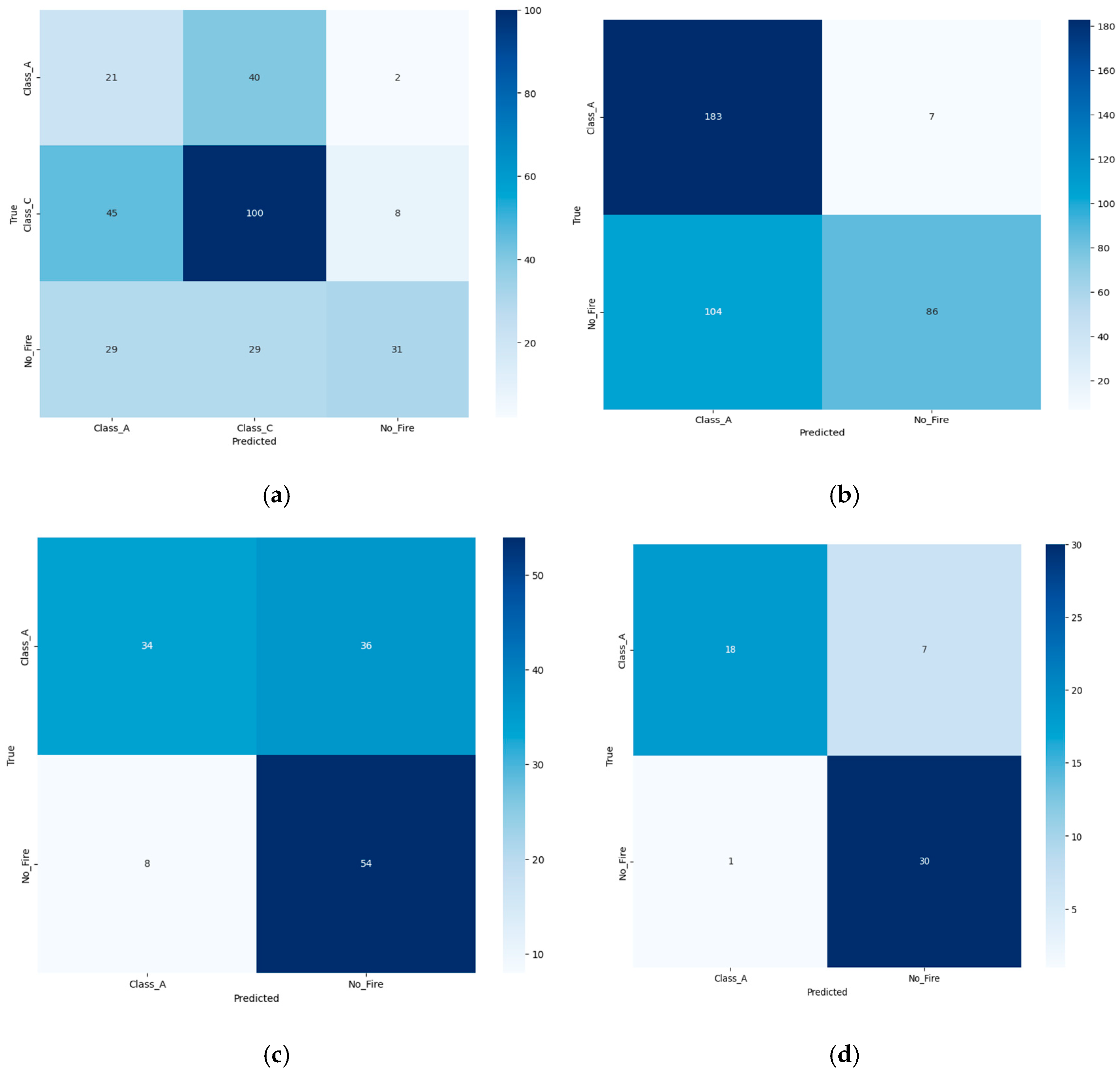
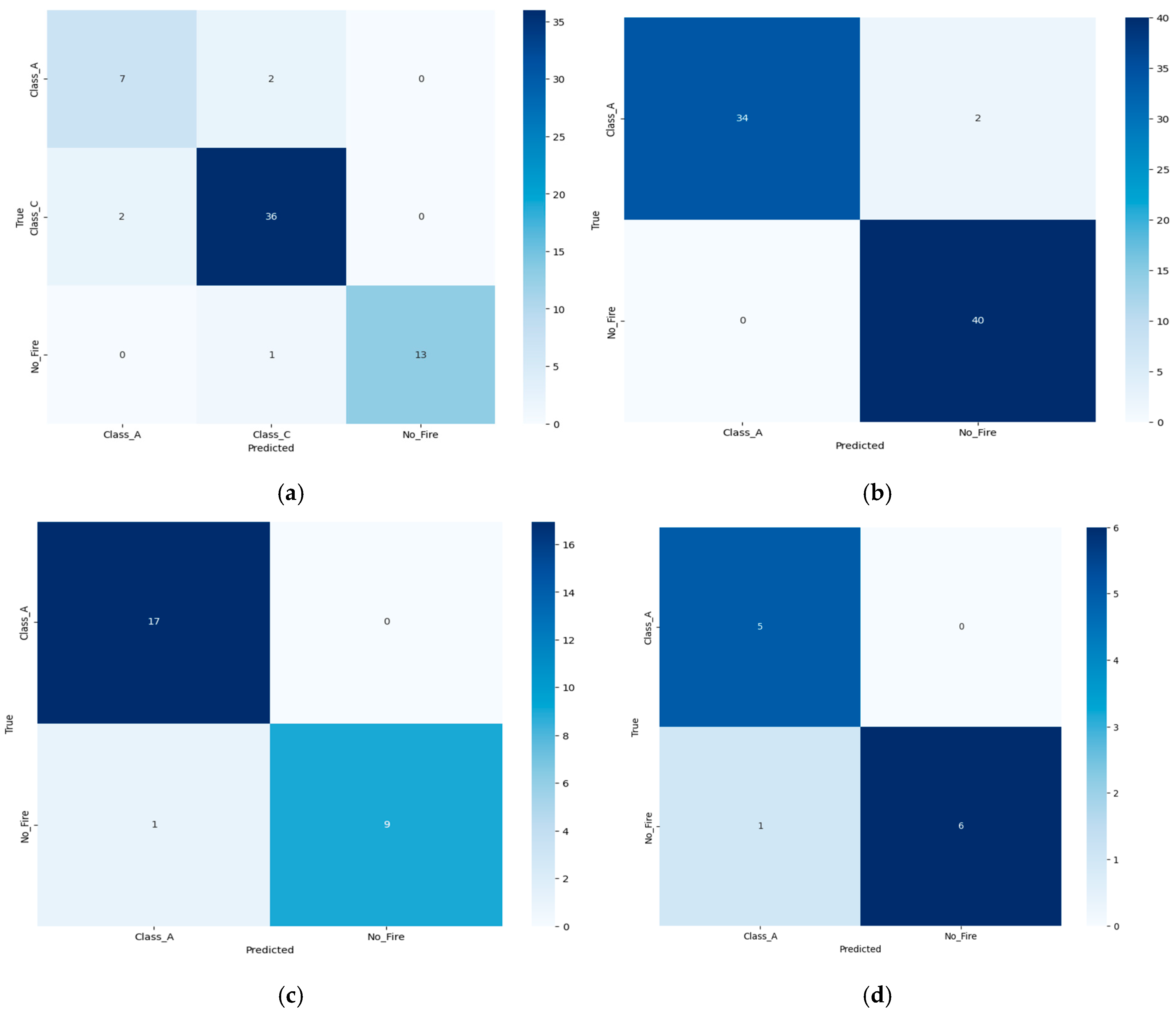
References
- NFPA 10; Standard for Portable Fire Extinguishers. NFPA: Quincy, MA, USA, 2018.
- Pivello, V.R.; Vieira, I.; Christianini, A.V.; Ribeiro, D.B.; da Silva Menezes, L.; Berlinck, C.N.; Melo, F.P.; Marengo, J.A.; Tornquist, C.G.; Tomas, W.M.; et al. Understanding Brazil’s catastrophic fires: Causes, consequences and policy needed to prevent future tragedies. Perspect. Ecol. Conserv. 2021, 19, 233–255. [Google Scholar] [CrossRef]
- Ganteaume, A.; Camia, A.; Jappiot, M.; San-Miguel-Ayanz, J.; Long-Fournel, M.; Lampin, C. A review of the main driving factors of forest fire ignition over Europe. Environ. Manag. 2013, 51, 651–662. [Google Scholar] [CrossRef] [PubMed]
- Stephens, S.L. Forest fire causes and extent on United States Forest Service lands. Int. J. Wildland Fire 2005, 14, 213–222. [Google Scholar] [CrossRef]
- NFBA Research: Structure Fires Involving Flammable Gases. Available online: https://www.nfpa.org/education-and-research/research/nfpa-research/fire-statistical-reports/structure-fires-involving-flammable-gases (accessed on 1 November 2024).
- National-Fire-Protection-Association. US Fire Adminstration Stats. 2024. Available online: https://www.usfa.fema.gov/statistics/ (accessed on 1 November 2024).
- Gaur, A.; Singh, A.; Kumar, A.; Kumar, A.; Kapoor, K. Video flame and smoke based fire detection algorithms: A literature review. Fire Technol. 2020, 56, 1943–1980. [Google Scholar] [CrossRef]
- Li, P.; Zhao, W. Image fire detection algorithms based on convolutional neural networks. Case Stud. Therm. Eng. 2020, 19, 100625. [Google Scholar] [CrossRef]
- Muhammad, K.; Ahmad, J.; Lv, Z.; Bellavista, P.; Yang, P.; Baik, S.W. Efficient deep CNN-based fire detection and localization in video surveillance applications. IEEE Trans. Syst. Man Cybern. Syst. 2018, 49, 1419–1434. [Google Scholar] [CrossRef]
- Muhammad, K.; Ahmad, J.; Mehmood, I.; Rho, S.; Baik, S.W. Convolutional neural networks based fire detection in surveillance videos. IEEE Access 2018, 6, 18174–18183. [Google Scholar] [CrossRef]
- Yang, Y.; Pan, M.; Li, P.; Wang, X.; Tsai, Y.T. Development and optimization of image fire detection on deep learning algorithms. J. Therm. Anal. Calorim. 2023, 148, 5089–5095. [Google Scholar] [CrossRef]
- Sharma, J.; Granmo, O.C.; Goodwin, M.; Fidje, J.T. Deep convolutional neural networks for fire detection in images. In Proceedings of the Engineering Applications of Neural Networks: 18th International Conference, EANN 2017, Athens, Greece, 25–27 August 2017; pp. 183–193. [Google Scholar]
- de Almeida Pereira, G.H.; Fusioka, A.M.; Nassu, B.T.; Minetto, R. Active fire detection in Landsat-8 imagery: A large-scale dataset and a deep-learning study. ISPRS J. Photogramm. Remote Sens. 2021, 178, 171–186. [Google Scholar] [CrossRef]
- Zhang, Q.; Xu, J.; Xu, L.; Guo, H. Deep convolutional neural networks for forest fire detection. In 2016 International Forum on Management, Education and Information Technology Application; Atlantis Press: Amsterdam, The Netherlands, 2016; pp. 568–575. [Google Scholar]
- Jiao, Z.; Zhang, Y.; Xin, J.; Mu, L.; Yi, Y.; Liu, H.; Liu, D. A deep learning based forest fire detection approach using UAV and YOLOv3. In Proceedings of the 2019 1st International conference on industrial artificial intelligence (IAI), Dublin, Ireland, 16–18 October 2019; pp. 1–5. [Google Scholar]
- Jin, C.; Wang, T.; Alhusaini, N.; Zhao, S.; Liu, H.; Xu, K.; Zhang, J. Video Fire Detection Methods Based on Deep Learning: Datasets, Methods, and Future Directions. Fire 2023, 6, 315. [Google Scholar] [CrossRef]
- Saydirasulovich, S.N.; Mukhiddinov, M.; Djuraev, O.; Abdusalomov, A.; Cho, Y.I. An improved wildfire smoke detection based on YOLOv8 and UAV images. Sensors 2023, 23, 8374. [Google Scholar] [CrossRef] [PubMed]
- Avazov, K.; Mukhiddinov, M.; Makhmudov, F.; Cho, Y.I. Fire detection method in smart city environments using a deep-learning-based approach. Electronics 2021, 11, 73. [Google Scholar] [CrossRef]
- Kim, B.; Lee, J. A video-based fire detection using deep learning models. Appl. Sci. 2019, 9, 2862. [Google Scholar] [CrossRef]
- Seydi, S.T.; Saeidi, V.; Kalantar, B.; Ueda, N.; Halin, A.A. Fire-Net: A Deep Learning Framework for Active Forest Fire Detection. J. Sens. 2022, 2022, 8044390. [Google Scholar] [CrossRef]
- Abdusalomov, A.B.; Islam, B.M.S.; Nasimov, R.; Mukhiddinov, M.; Whangbo, T.K. Abdusalomov. An improved forest fire detection method based on the detectron2 model and a deep learning approach. Sensors 2023, 23, 1512. [Google Scholar] [CrossRef]
- Yar, H.; Hussain, T.; Agarwal, M.; Khan, Z.A.; Gupta, S.K.; Baik, S.W. Optimized dual fire attention network and medium-scale fire classification benchmark. IEEE Trans. Image Process. 2022, 31, 6331–6343. [Google Scholar] [CrossRef]
- Xue, Q.; Lin, H.; Wang, F. Fcdm: An improved forest fire classification and detection model based on yolov5. Forests 2022, 13, 2129. [Google Scholar] [CrossRef]
- Khan, S.; Khan, A. Ffirenet: Deep learning based forest fire classification and detection in smart cities. Symmetry 2022, 14, 2155. [Google Scholar] [CrossRef]
- Akagic, A.; Buza, E. Lw-fire: A lightweight wildfire image classification with a deep convolutional neural network. Appl. Sci. 2022, 12, 2646. [Google Scholar] [CrossRef]
- Lee, J.; Kang, J.; Park, C.S.; Jeong, J. Distributed Fire Classification and Localization Model Based on Federated Learning with Image Clustering. Appl. Sci. 2024, 14, 9162. [Google Scholar] [CrossRef]
- Refaee, E.A.; Sheneamer, A.; Assiri, B. A Deep-Learning-Based Approach to the Classification of Fire Types. Appl. Sci. 2024, 14, 7862. [Google Scholar] [CrossRef]
- Park, M.; Tran, D.Q.; Lee, S.; Park, S. Multilabel image classification with deep transfer learning for decision support on wildfire response. Remote Sens. 2021, 13, 3985. [Google Scholar] [CrossRef]
- Khan, A.; Hassan, B.; Khan, S.; Ahmed, R.; Adnan, A. Available online: https://www.kaggle.com/datasets/alik05/forest-fire-dataset (accessed on 1 November 2024).
- Yang, J.; Zhu, W.; Sun, T.; Ren, X.; Liu, F. Lightweight forest smoke and fire detection algorithm based on improved YOLOv5. PLoS ONE 2023, 18, e0291359. [Google Scholar] [CrossRef] [PubMed]
- Refaee, E. Fire Type Classes Dataset. 2024. Available online: https://zenodo.org/records/13119922?preview=1&token=eyJhbGciOiJIUzUxMiJ9.eyJpZCI6ImI0NjA1OWRlLWM1ZjctNDM0NS04Mjk0LTA1OGViNzA1Zjg2MCIsImRhdGEiOnt9LCJyYW5kb20iOiIyZDE3NjBlMTQ4YzNmZDQ0MmQzMTZiODgzZThmMzk5OCJ9.q7irvvmF2Ecs6u1hSOlz8Ny2QgHp1FksziQCFCrgcawqkwrDi47vVkRmksXMuLwNpkz0pi4AtzCA489aAR76Gg (accessed on 1 November 2024).
- Chino, D.Y.; Avalhais, L.P.; Rodrigues, J.F.; Traina, A.J. Bowfire: Detection of fire in still images by integrating pixel color and texture analysis. In Proceedings of the 2015 28th SIBGRAPI Conference on Graphics, Patterns and Images, Salvador, Brazil, 26–29 August 2015; pp. 95–102. [Google Scholar]
- Hazard Control Technologies. Available online: https://www.youtube.com/@hazardcontroltechnologies (accessed on 1 November 2024).
- Fire at Fast Food Resturant. Safety Video. Available online: https://www.youtube.com/@safetyvideos9453 (accessed on 1 November 2024).
- Firemill Extinguisher. Kitchen Fire. Available online: https://www.youtube.com/watch?v=WpTGTwzQtOs (accessed on 1 November 2024).
- Cofessco Fire Protection. Class K Fire Extinguishers vs. Other Agents: Cofessco Fire Protection. Available online: https://www.youtube.com/watch?v=X4GPxV_2vV0&t=461s (accessed on 1 November 2024).
- Alif, M.A.R. YOLOv11 for Vehicle Detection: Advancements, Performance, and Applications in Intelligent Transportation Systems. arXiv 2014, arXiv:2410.22898. [Google Scholar]
- Paul, P.T. YOLO11: The Cutting-Edge Evolution in Object Detection—A Brief Review of the Latest in the Yolo Series. Available online: https://medium.com/@paultsoi1014/yolo11-the-cutting-edge-evolution-in-object-detection-a-brief-review-of-the-latest-in-the-yolo-19065729edfe (accessed on 1 November 2024).
- Jegham, N.; Koh, C.Y.; Abdelatti, M.; Hendawi, A. Evaluating the Evolution of YOLO (You Only Look Once) Models: A Comprehensive Benchmark Study of YOLO11 and Its Predecessors. arXiv 2024, arXiv:2411.00201. [Google Scholar]
- Howard, A.G. Mobilenets: Efficient convolutional neural networks for mobile vision applications. arXiv 2017, arXiv:1704.04861. [Google Scholar]
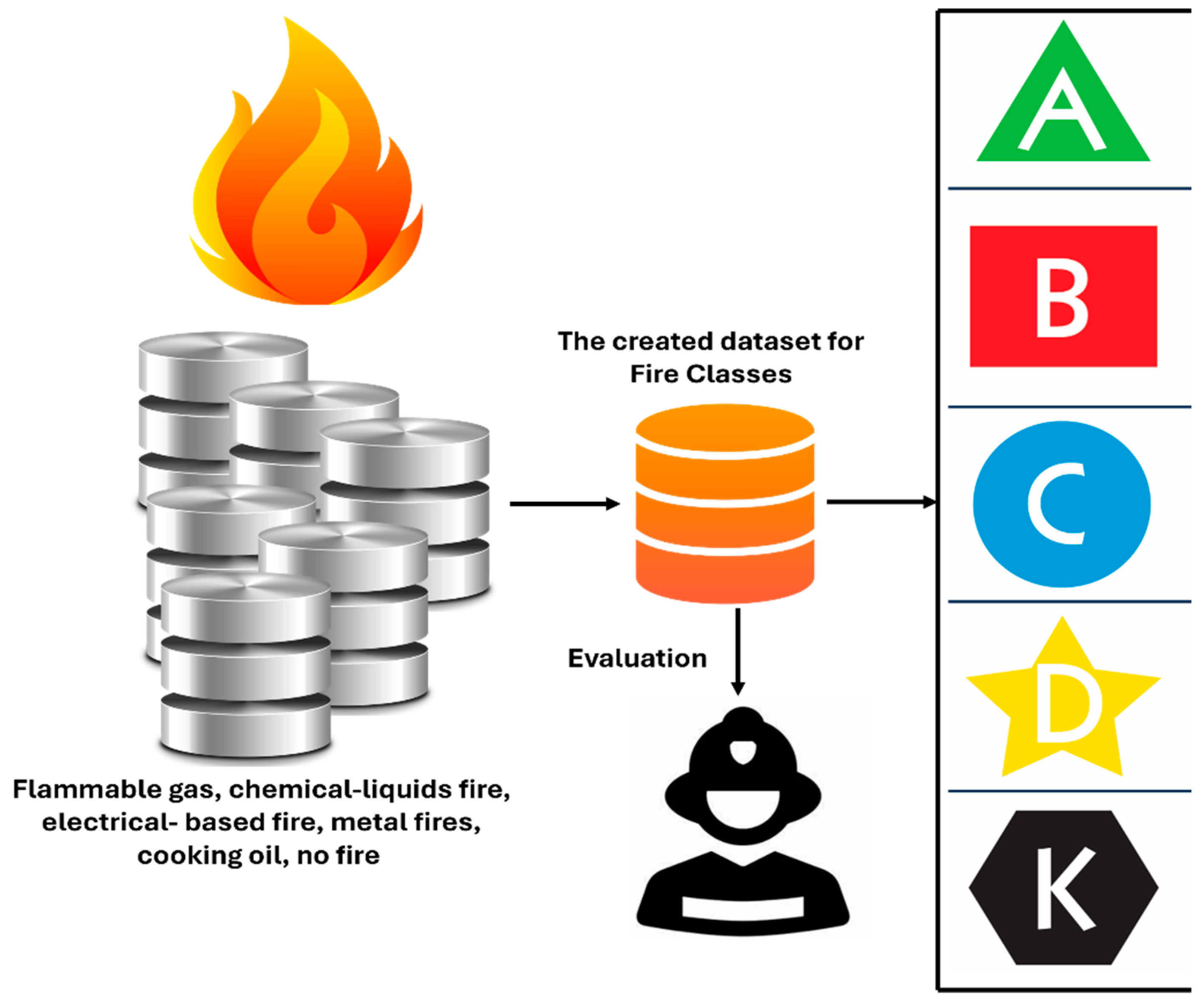
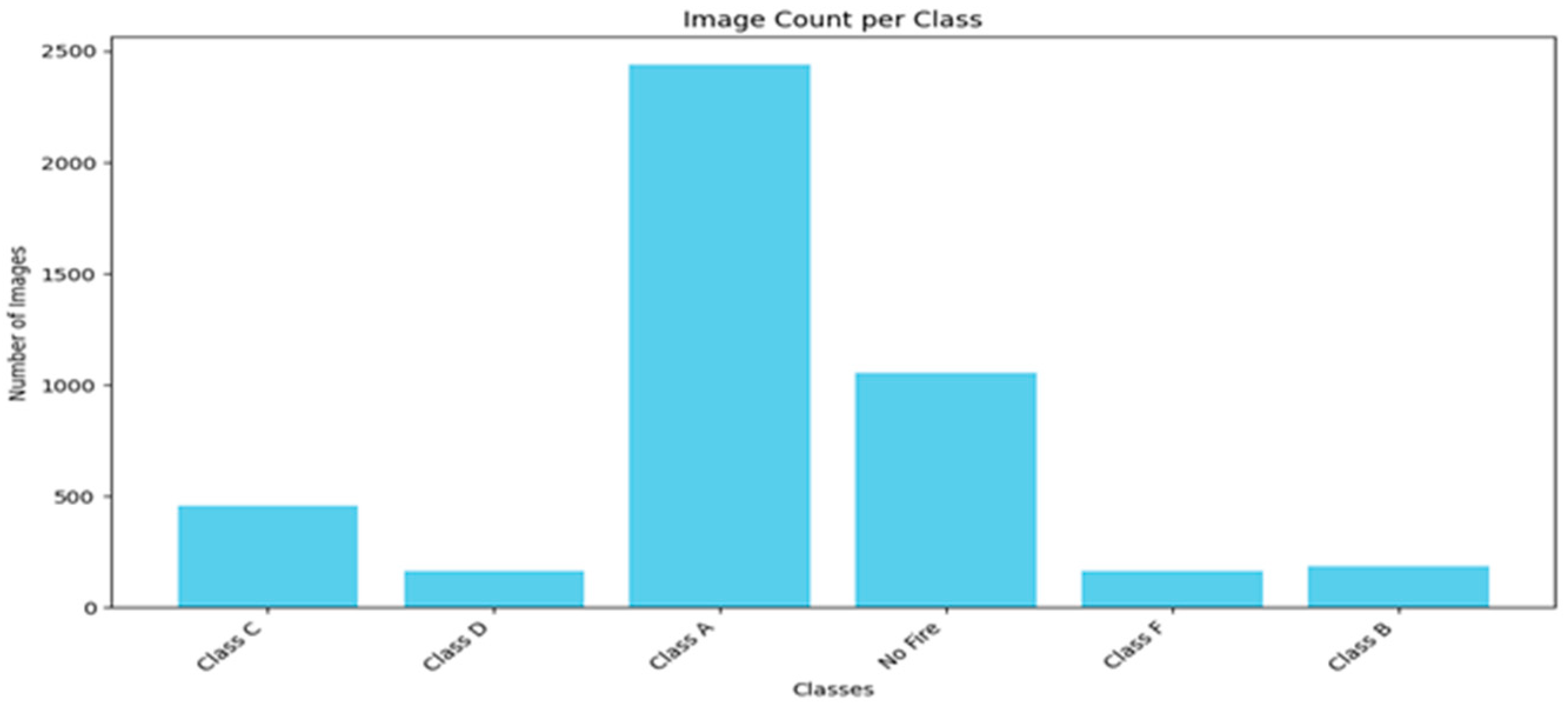
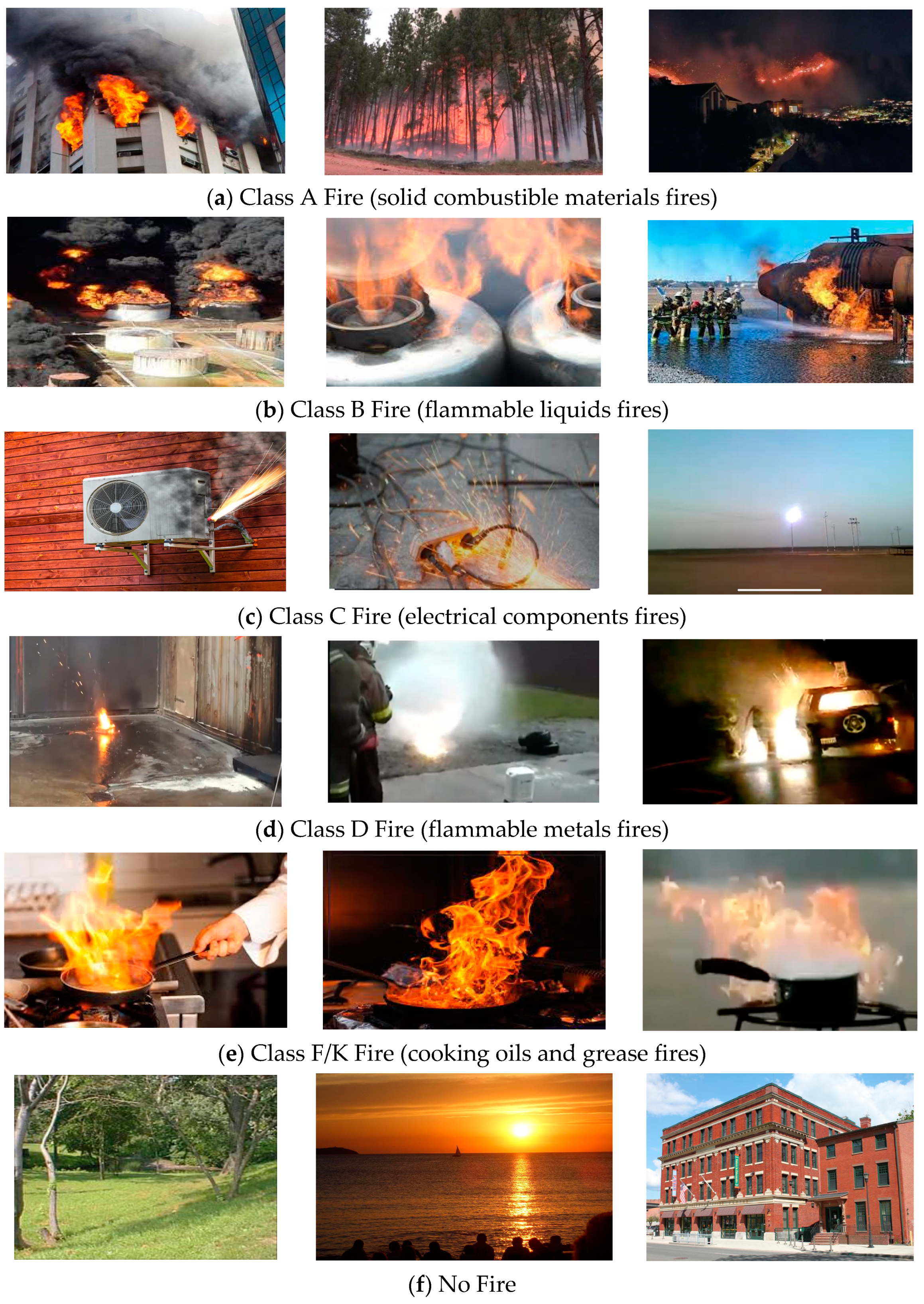
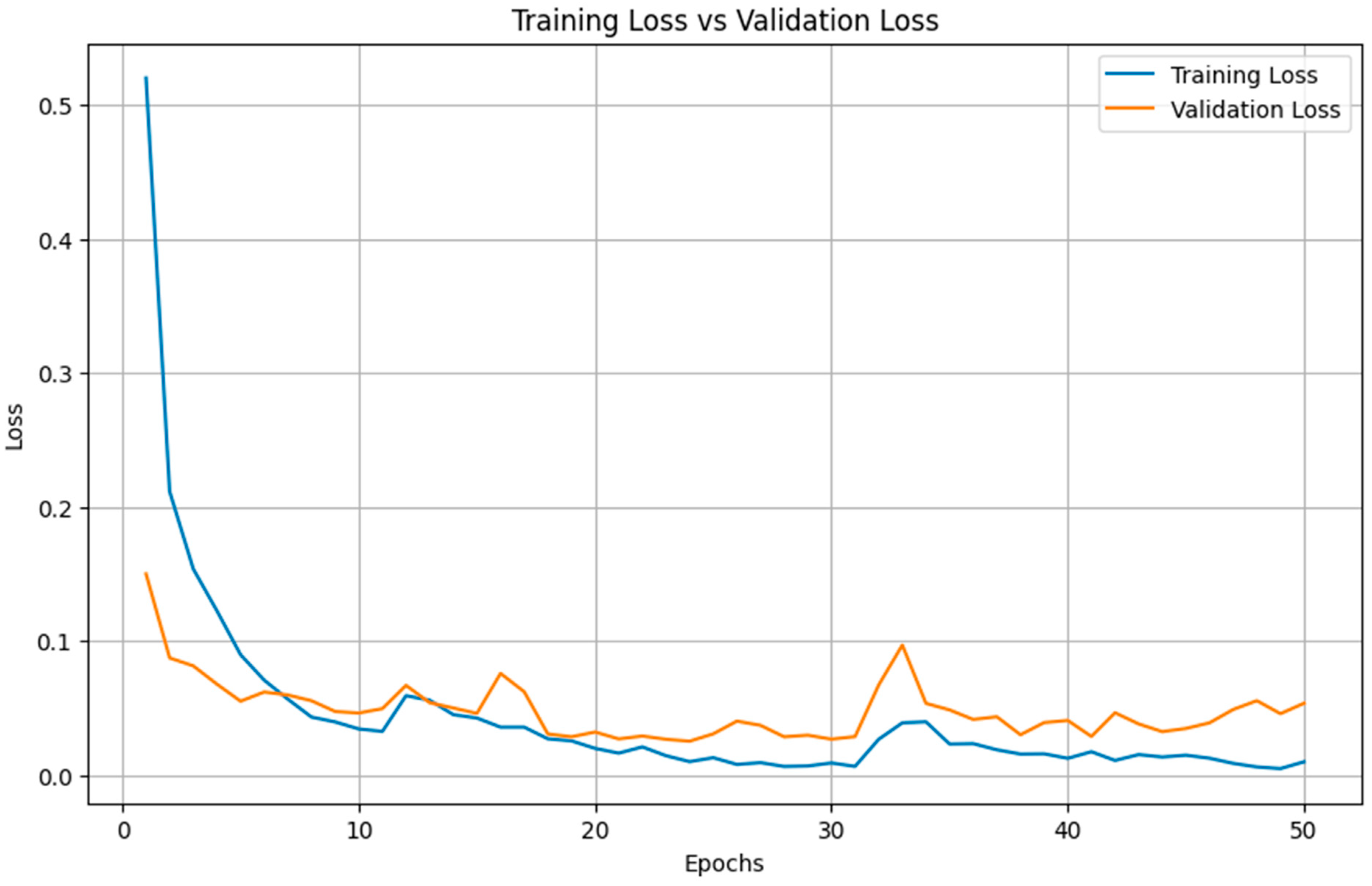
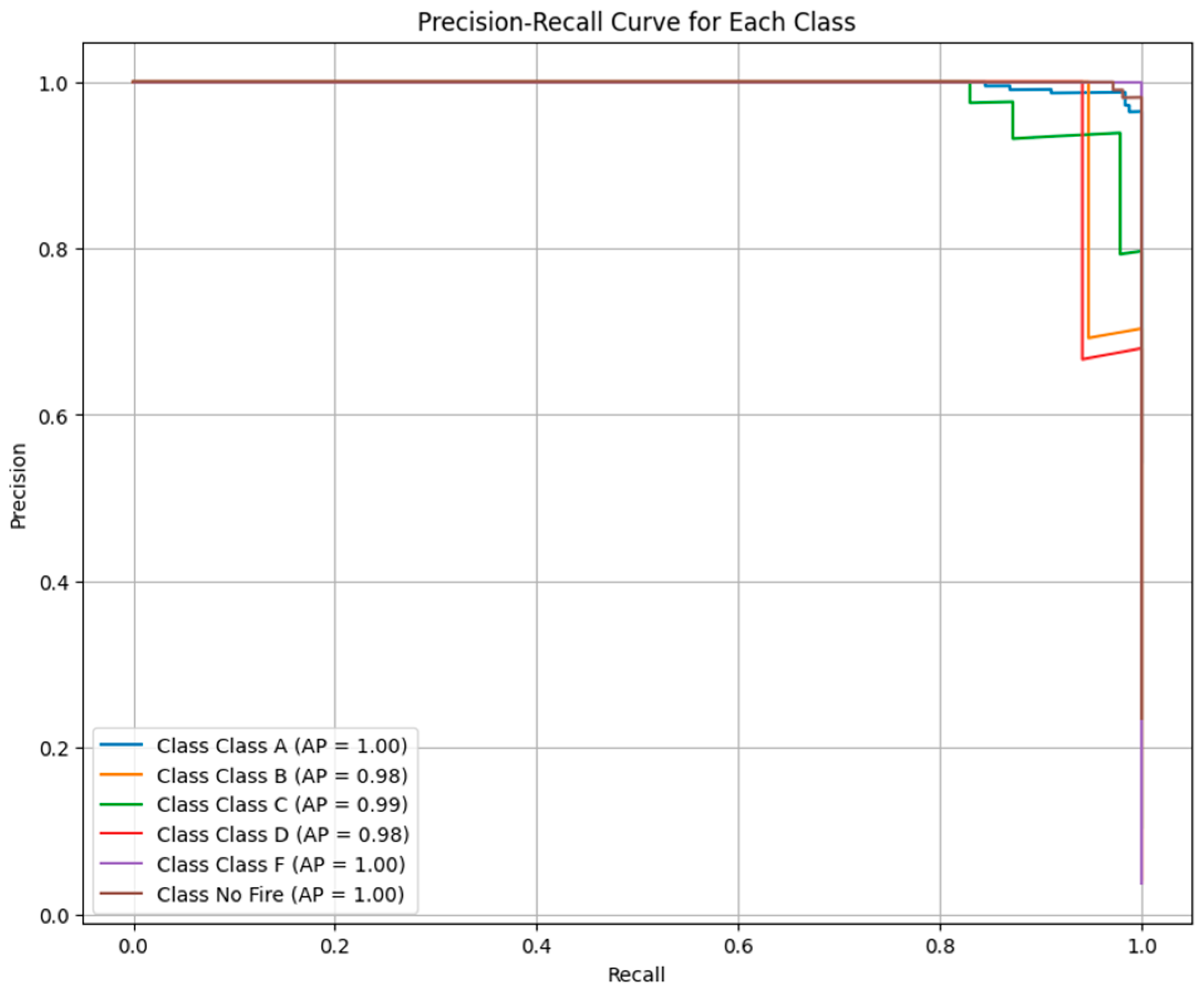
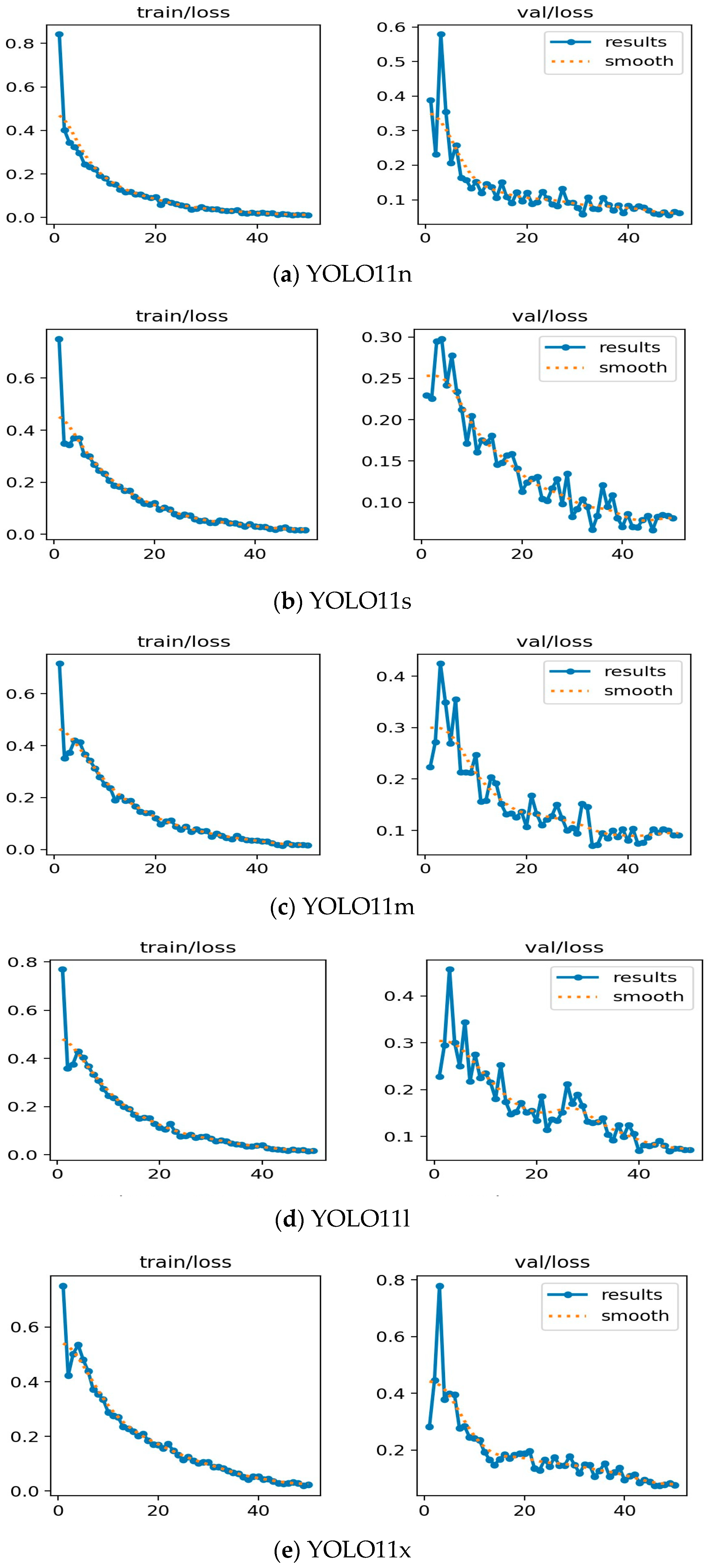
| Study | Approach | Key Contributions | Applications |
|---|---|---|---|
| Yar, Hikmat et al. [22] | DFAN with attention mechanisms | Enhanced fire detection speed (50% FPS), and outperformed 21 state-of-the-art methods | Fire classification and detection |
| Xue, Q., Lin, H., and Wang, F. [23] | YOLOv5-based model with CBAM attention and SIoU Loss | Improved forest fire detection accuracy and outperformed YOLOv5 | Forest fire classification and detection |
| Khan, S. and Khan, A. [24] | FFireNet using MobileNetV2 | 98.42% accuracy, 99.47% recall, and 97.42% precision | Forest fire classification |
| Akagic, A. and Buza, E. [25] | LW-FIRE with CNN architecture | High accuracy via dataset transformation method | Wildfire image classification |
| Lee, Jiwon et al. [26] | Federated learning and clustering | 99% accuracy, effective clustering, NMI is above 0.6, and silhouette is 0.9 | Fire classification systems |
| Refaee, E. A. et al. [27] | Multi-model classification system | Benchmark dataset with 1353 images. A 98.16% accuracy for fire detection and 97.55 accuracy for fire-type classification (two-level~classification) | Fire type classification and detection |
| Park, Minsoo et al. [28] | MLC model with transfer learning | Enhanced multilabel classification with reliable heatmaps and robust performance with pretrained models | Wildfire image classification |
| Backbone | YOLO11n-cls
|
| Attention mechanism | Attention applied to YOLO11n-cls and MobileNet features using Conv2D, BatchNorm2D, and Sigmoid activation |
| Adaptive Average Pooling | |
| Feature Concatenation: Merges YOLO11n-cls and MobileNet feature vectors | |
| Head | Fully connected (linear) layer, batch normalization, and final linear layer for classification |
| Parameter | Value |
|---|---|
| Epochs | 50 |
| Batch size | 16 |
| Optimal algorithm | Adam |
| Model weight | YOLO11n, YOLO11s, YOLO11m, YOLO11l, and YOLO11x |
| Name | Type |
|---|---|
| CPU | Intel Xeon CPU @ 2.20 GHz |
| GPU | NVIDIA Tesla T4 GPU |
| RAM | 32 GB |
| Framework | PyTorch 2.5 |
| Accelerator | Tesla T4 |
| YOLO11n | YOLO11s | YOLO11m | YOLO11l | YOLO11x | |||||||||||
|---|---|---|---|---|---|---|---|---|---|---|---|---|---|---|---|
| Precision | Recall | F1 Score | Precision | Recall | F1 Score | Precision | Recall | F1 Score | Precision | Recall | F1 Score | Precision | Recall | F1 Score | |
| Class A | 0.96 | 0.98 | 0.97 | 0.96 | 0.99 | 0.98 | 0.98 | 0.98 | 0.98 | 0.98 | 0.98 | 0.98 | 0.97 | 0.97 | 0.97 |
| Class B | 0.95 | 0.95 | 0.95 | 0.94 | 0.84 | 0.89 | 1.00 | 0.95 | 0.97 | 0.94 | 0.89 | 0.92 | 0.81 | 0.89 | 0.85 |
| Class C | 0.93 | 0.85 | 0.89 | 0.98 | 0.89 | 0.93 | 0.96 | 0.94 | 0.95 | 0.92 | 0.96 | 0.94 | 0.98 | 0.89 | 0.93 |
| Class D | 0.94 | 1.00 | 0.97 | 0.94 | 0.94 | 0.94 | 0.89 | 1.00 | 0.94 | 0.94 | 1.00 | 0.97 | 0.89 | 1.00 | 0.94 |
| Class F | 0.94 | 1.00 | 0.97 | 0.94 | 1.00 | 0.97 | 0.94 | 1.00 | 0.97 | 1.00 | 0.94 | 0.97 | 0.94 | 0.88 | 0.91 |
| No Fire | 1.00 | 0.99 | 1.00 | 0.99 | 0.98 | 0.99 | 0.98 | 0.98 | 0.98 | 0.99 | 0.97 | 0.98 | 0.98 | 0.98 | 0.98 |
| Accuracy | 0.97 | 0.97 | 0.97 | 0.97 | 0.96 | ||||||||||
| Macro avg | 0.96 | 0.96 | 0.96 | 0.96 | 0.94 | 0.95 | 0.96 | 0.97 | 0.97 | 0.96 | 0.96 | 0.96 | 0.93 | 0.94 | 0.93 |
| Weighted avg | 0.97 | 0.97 | 0.97 | 0.97 | 0.97 | 0.97 | 0.97 | 0.97 | 0.97 | 0.97 | 0.97 | 0.97 | 0.96 | 0.96 | 0.96 |
| Precision | Recall | F1 Score | |
|---|---|---|---|
| Class A | 0.98 | 0.98 | 0.98 |
| Class B | 1.00 | 0.95 | 0.97 |
| Class C | 0.90 | 0.96 | 0.93 |
| Class D | 1.00 | 0.94 | 0.97 |
| Class F | 1.00 | 1.00 | 1.00 |
| No Fire | 0.98 | 0.98 | 0.98 |
| Accuracy | 0.98 | ||
| Macro Avg | 0.98 | 0.97 | 0.97 |
| Weighted Avg | 0.98 | 0.98 | 0.98 |
| YOLOv8n | YOLOv8s | Hybrid Model | |||||||
|---|---|---|---|---|---|---|---|---|---|
| Precision | Recall | F1 Score | Precision | Recall | F1 Score | Precision | Recall | F1 Score | |
| Class A | 0.98 | 1.00 | 0.99 | 0.97 | 0.99 | 0.98 | 0.98 | 0.98 | 0.98 |
| Class B | 0.94 | 0.84 | 0.89 | 0.94 | 0.84 | 0.89 | 1.00 | 0.95 | 0.97 |
| Class C | 0.95 | 0.89 | 0.92 | 0.93 | 0.87 | 0.90 | 0.90 | 0.96 | 0.93 |
| Class D | 0.85 | 1.00 | 0.92 | 0.94 | 1.00 | 0.97 | 1.00 | 0.94 | 0.97 |
| Class F | 0.83 | 0.88 | 0.86 | 0.94 | 1.00 | 0.97 | 1.00 | 1.00 | 1.00 |
| No Fire | 0.99 | 0.96 | 0.98 | 0.99 | 0.97 | 0.98 | 0.98 | 0.98 | 0.98 |
| Accuracy | 0.97 | 0.97 | 0.98 | ||||||
| Macro avg | 0.92 | 0.93 | 0.93 | 0.95 | 0.95 | 0.95 | 0.98 | 0.97 | 0.97 |
| Weighted avg | 0.97 | 0.97 | 0.97 | 0.97 | 0.97 | 0.97 | 0.98 | 0.98 | 0.98 |
| Model | Epoch | Dataset | Accuracy | Task | F1 Score |
|---|---|---|---|---|---|
| MobileNetV2 | 300 | The dataset includes 1353 instances, with 541 labeled as no fire, 308 as wood and solid materials, 163 as flammable gas and chemical liquid fire, 187 electrical based fire, and 154 as oil-based fires. | 94.48 | Fire classification of fire types | 0.944 |
| The proposed hybrid model | 50 | The proposed dataset | 0.98 | Fire classification of fire classes | 0.98 |
Disclaimer/Publisher’s Note: The statements, opinions and data contained in all publications are solely those of the individual author(s) and contributor(s) and not of MDPI and/or the editor(s). MDPI and/or the editor(s) disclaim responsibility for any injury to people or property resulting from any ideas, methods, instructions or products referred to in the content. |
© 2025 by the author. Licensee MDPI, Basel, Switzerland. This article is an open access article distributed under the terms and conditions of the Creative Commons Attribution (CC BY) license (https://creativecommons.org/licenses/by/4.0/).
Share and Cite
Alkhammash, E.H. Multi-Classification Using YOLOv11 and Hybrid YOLO11n-MobileNet Models: A Fire Classes Case Study. Fire 2025, 8, 17. https://doi.org/10.3390/fire8010017
Alkhammash EH. Multi-Classification Using YOLOv11 and Hybrid YOLO11n-MobileNet Models: A Fire Classes Case Study. Fire. 2025; 8(1):17. https://doi.org/10.3390/fire8010017
Chicago/Turabian StyleAlkhammash, Eman H. 2025. "Multi-Classification Using YOLOv11 and Hybrid YOLO11n-MobileNet Models: A Fire Classes Case Study" Fire 8, no. 1: 17. https://doi.org/10.3390/fire8010017
APA StyleAlkhammash, E. H. (2025). Multi-Classification Using YOLOv11 and Hybrid YOLO11n-MobileNet Models: A Fire Classes Case Study. Fire, 8(1), 17. https://doi.org/10.3390/fire8010017








